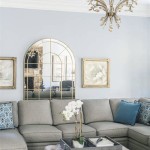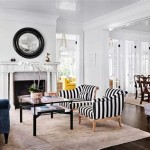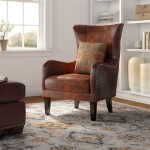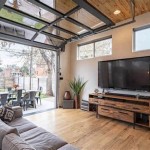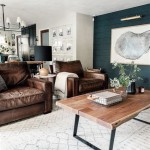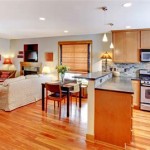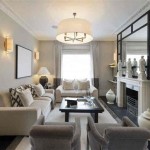Creating Harmonious Dining Room Living Room Combinations
The open-plan living area, integrating the dining room and living room, has become increasingly popular in modern home design. This layout maximizes space, fosters a sense of connectivity, and promotes a more casual and versatile lifestyle. However, designing a cohesive and functional dining room living room combination requires careful consideration of several factors. The objective is to create distinct yet complementary spaces that blend seamlessly together, enhancing both the aesthetic appeal and the practicality of the home.
Successfully combining these two functional spaces involves thoughtful planning of layout, furniture selection, color palettes, and lighting. The goal is to establish a visual harmony that reflects the homeowner’s personal style while maintaining the individual identities of the dining and living areas.
Defining Spaces within an Open Layout
One of the primary challenges in a dining room living room combination is defining distinct zones without erecting physical barriers. Strategic furniture placement is often the most effective solution. A large sectional sofa can delineate the living room area, its back acting as an implied boundary. Similarly, a strategically positioned area rug can visually anchor the living room furniture, creating a defined space within the larger open area.
In the dining area, a prominent dining table and chairs naturally define the space's purpose. Consider the size and shape of the table in relation to the overall room dimensions. A round table can work well in smaller spaces, promoting conversation and intimacy, while a rectangular table is suitable for larger gatherings and formal dining. A sideboard or console table placed along a wall can further define the dining area and provide storage for dinnerware and serving pieces.
Beyond furniture arrangement, architectural elements can also contribute to spatial definition. A partial wall, a decorative screen, or even a change in flooring can subtly differentiate the two areas. For instance, hardwood floors in the living room and tile or laminate in the dining area can visually separate the spaces. Varying ceiling heights or incorporating architectural details like columns or beams can also create a more defined sense of separation.
Consider the flow of traffic between the two spaces. Ensure ample pathways for comfortable movement and avoid creating bottlenecks. The furniture arrangement should encourage a natural and intuitive flow, preventing the feeling of being confined or crowded.
Establishing a Cohesive Aesthetic
While defining distinct spaces is important, maintaining a cohesive aesthetic throughout the dining room living room combination is crucial for creating a harmonious environment. This can be achieved through a consistent color palette, complementary furniture styles, and shared decorative elements. The key is to find a balance between individuality and unity, ensuring that the two spaces feel connected and integrated.
Select a color palette that flows seamlessly from one area to the other. Choose a dominant color and two or three accent colors that can be used throughout the space. The dominant color can be used on the walls, while the accent colors can be incorporated through furniture, accessories, and artwork. Maintaining a consistent color scheme will help to visually unify the two areas and create a sense of continuity.
Furniture styles should also complement each other. While the furniture in each area doesn't need to be identical, it should share a common aesthetic. For example, if the living room features modern furniture with clean lines, the dining room furniture should also incorporate similar design elements. Mixing furniture styles can be effective, but it requires careful consideration to avoid creating a jarring or disjointed look. A transitional approach, blending traditional and modern elements, often works well in open-plan layouts.
Shared decorative elements can further enhance the cohesiveness of the space. Incorporate similar patterns, textures, and materials in both the dining and living areas. For instance, if the living room features cushions with a geometric pattern, consider using the same pattern on the dining room chairs or in a tablecloth. Using similar materials, such as wood, metal, or glass, throughout the space can also create a sense of continuity.
Artwork is another powerful tool for creating a cohesive aesthetic. Choose artwork that complements the color palette and style of both the dining and living areas. A gallery wall that extends across both spaces can visually connect the two areas and create a focal point.
Optimizing Lighting for Functionality and Ambiance
Lighting plays a crucial role in creating a functional and inviting dining room living room combination. Different lighting schemes are required for each area to accommodate their specific purposes. The living room typically benefits from ambient, task, and accent lighting, while the dining room requires a combination of ambient and task lighting. Layering these different types of lighting will create a well-balanced and versatile lighting scheme.
In the living room, ambient lighting can be provided by recessed lights, chandeliers, or floor lamps. Task lighting is essential for reading and other activities, and can be provided by table lamps or floor lamps. Accent lighting is used to highlight artwork or architectural features, and can be provided by spotlights or track lighting. Dimmers are highly recommended for living room lighting, allowing the light levels to be adjusted depending on the mood and activity.
In the dining room, a chandelier or pendant light suspended above the dining table provides both ambient and task lighting. The size and style of the fixture should be appropriate for the size and shape of the table. Consider the height of the ceiling when choosing a fixture, and ensure that it hangs at a comfortable height above the table. Additional lighting can be provided by wall sconces or recessed lights.
The lighting in both areas should be coordinated to create a cohesive look. Use similar light bulbs throughout the space to maintain a consistent color temperature. Avoid mixing warm and cool light bulbs, as this can create a jarring effect. Consider using smart lighting systems that allow you to control the lighting in both areas with a single device. This can be especially convenient for setting different lighting scenes for different activities.
Natural light is also an important consideration. Maximize natural light by keeping windows clear and using sheer curtains or blinds. Natural light can help to brighten the space and create a more inviting atmosphere.
Selecting Furniture for Comfort and Style
Furniture selection is critical in creating a functional and aesthetically pleasing dining room living room combination. The furniture should be comfortable, durable, and appropriate for the size and style of the space. Consider the scale of the furniture in relation to the overall room dimensions. Oversized furniture can overwhelm a small space, while undersized furniture can feel lost in a large space.
In the living room, a comfortable sofa is the centerpiece. Choose a sofa that is the right size and shape for the space, and that is comfortable for lounging and entertaining. Sectional sofas are a popular choice for open-plan living areas, as they can provide ample seating and help to define the living room space. Armchairs, coffee tables, and side tables are also essential living room furniture pieces. Consider the functionality of each piece when making your selection. For example, a coffee table with storage can provide additional storage space, while a side table with a lamp can provide task lighting.
In the dining room, the dining table and chairs are the focal point. Choose a table that is the right size and shape for your needs, and that is made from durable materials. Consider the number of people you typically entertain when selecting a table size. Dining chairs should be comfortable and stylish, and should complement the style of the table. A sideboard or console table can provide additional storage space and can also serve as a serving station.
The furniture in both areas should be chosen to complement each other. Consider the color, style, and materials of the furniture when making your selection. Avoid choosing furniture that clashes or feels out of place. It is recommended to select a specific style before choosing furniture; that way, the selection feels coordinated and intentional.
Incorporating Storage Solutions
Adequate storage is essential for maintaining a clutter-free and organized dining room living room combination. Open-plan layouts can easily become visually cluttered if storage is not carefully considered. Integrating storage solutions into the design is crucial for maximizing space and creating a more functional and inviting environment.
In the living room, consider incorporating storage ottomans, coffee tables with storage, and bookshelves. These pieces can provide ample storage space for blankets, pillows, books, and other living room essentials. A media console can also provide storage for electronic equipment and media. Wall-mounted shelves can be a stylish and space-saving storage solution.
In the dining room, a sideboard or console table is an essential storage piece. It can provide storage for dinnerware, serving pieces, and other dining room essentials. A china cabinet can also be a stylish and functional storage solution for displaying fine china and glassware. Consider incorporating built-in cabinets or shelves for a more streamlined and integrated storage solution.
When choosing storage solutions, consider the style of the space and the amount of storage space needed. Choose storage pieces that complement the overall aesthetic of the room and that provide adequate storage for your needs. Maximize vertical space by using tall bookshelves or cabinets. This can help to create a more spacious and organized feel.
Think vertically. Shelving units are often a great way to add visual interest while also providing storage for books, photos, and other decorative items. Open shelving can display curated collections, while closed cabinets can conceal clutter. Combining both open and closed storage creates a balanced and functional space.

54 Simple Ideas For Small Living Room Dining Combo Edward George

Living Room And Dining Design Ideas Designcafe

Living Room And Dining Decorating Ideas Design Hgtv
:max_bytes(150000):strip_icc()/af1be3_d1cdc3d7584f411089ac7387c1645aa7mv2-2c6d171df056450a8a49f3422754f3dd.jpeg?strip=all)
27 Living Room Dining Combos

54 Simple Ideas For Small Living Room Dining Combo Edward George

Living Room And Dining Design Ideas Designcafe

39 Living Room Dining Combos To Maximize Your Space

Living Room Dining Combo Ideas With Tricks Doğtaş

How To Layout Small Living Dining Combos 25 Creative Ideas Gws Masonry Home Improvement

8 Tips On How To Separate Living And Dining Areas

